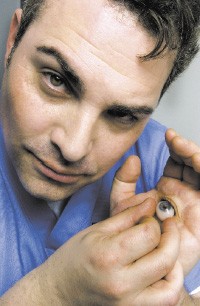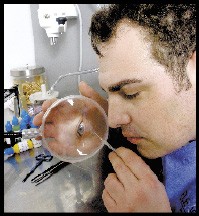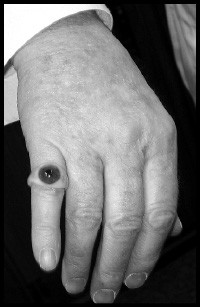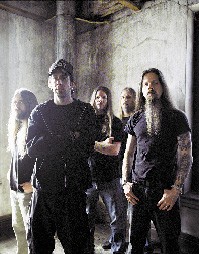Matt Singer rummages fitfully through a desk drawer, pushing aside disembodied ears and other bits of pink, porous tissue. “I know what it feels like to be obsolete,” he grumbles, recalling the days before computer-generated film images, when an artist with his peculiar skills had a future in the motion picture industry. He finds the computer disc he was searching for, slips it into his laptop, and settles back into a chair beneath a poster of Blackstone the Magician. His brightly lit office suite is part clinic, part art studio, and part sci-fi lab for a mad inventor.
“This is what I do now,” he says, and a gallery of ravaged human faces materializes on the screen. He clicks through pictures of burn patients and cancer survivors, a shudder-inducing parade of disfigurement and calamity. He points to an unsmiling picture of a dark-haired young woman. “This woman was swimming underwater,” he says. “Some kids were throwing rocks and when she came up for air — bang. She lost an eye.”
In the next room, Singer’s assistants, Nick Pena, a former art professor at the University of Missouri, and Charles Etinger, a Memphis-bred cartoonist, are layering bands of molten color into soft silicone eyes.
 Jonathan Postal
Jonathan Postal
Matt Singer
By the time the Venetians invented the glass eye in the 15th century, ocular prostheses had been in use for nearly 2,000 years. The earliest known examples were created by ancient Egyptians, who painted clay discs that were attached by strips of linen. In the mid-19th century, German artisans perfected a technique for producing a prosthetic-grade art-glass eye. The technique was kept secret and handed down from one generation to the next. The German eye-making monopoly became a problem during WWII, when wounded American soldiers returned home needing ocular prosthetics that were increasingly unavailable. American ocularists and Army dentists worked with plastics and oil-based pigments to create the first acrylic prosthetic eyes, which are now — excepting Germany and parts of Europe where glass is still preferred — a global standard.
Which is where Singer comes in. He thinks his silicone “flexiglass” prosthetic is the logical evolutionary step in artificial eyes. Singer’s eye has been FDA-approved, and clinical trials began in June 2005. His prosthetic eyes have received rave reviews from users and have caught the attention of a few established ocularists.
But some very important people remain unconvinced.
“I did, in fact, find it crude,” said Heather Banfield, the education chair for the American Society of Ocularists (ASO). “If a student ocularist were to submit to us a finished acrylic prosthesis equivalent to this finished silicone prosthesis, this student would not pass the practical exam.”
Singer sent Banfield a sample eye hoping that he might be invited to teach a class at the ASO’s next conference. He wasn’t surprised when his petition to teach was denied, but he was annoyed when Banfield forwarded his creation to ASO president Bud Turntine instead of returning it to Memphis. He was staggered by her criticism.
“I can guarantee you, I’m 10 times the artist she is,” Singer rages like a wounded maestro. He dismisses Banfield’s comments as reactionary. “It’s an awful feeling, being obsolete,” he says.
 Jonathan Postal
Jonathan Postal
Before moving to Memphis, Singer was a special-effects makeup artist in Hollywood. He made monsters, robots, and aliens for films such as Bicentennial Man, Species II, and Star Trek: Nemesis. He sculpted lifelike body parts that could wiggle, squirm, explode, and gush blood. The high-strung artist felt right at home in the hectic environment of a film set. But as they say in the movie trailers, something happened to Matt Singer in 1992 that would change his life forever.
“I saw Jurassic Park,” he says. “That’s when I knew I had to figure out something else to do. Who needs monster makeup when you can make dinosaurs that real on a computer?” After 14 years in L.A., Singer moved to Memphis with a wife, some pets, a few spare body parts, and a plan. Actually several plans, all involving mold-making and cast silicone. He sold his special-effects makeup process to Saturday Night Live, taught at Memphis College of Art, opened his own short-lived school for prosthetic makeup artists, and pitched his services to crime-scene investigators, doctors, and Memphis-area theaters. He even had plans for a silicone-based wrinkle cream to sell on QVC that he half-jokingly called his “retirement plan.” Now, instead of making monsters, he unmakes them. He’s an illusionist who makes fake body parts for people who have lost real ones.
“You can’t actually replace the things that are gone,” he says of the work he did through UT-Memphis before opening his own office. “You can make something that gives the person a sense of being whole.”
Singer does noses, cheeks, chins, and foreheads. But an FDA-approved process for making soft ocular prosthetics is potentially a very valuable commodity. Singer sees the future in eyes, and he thinks the ASO’s resistance is the ultimate proof that his eyes have legs.
Eye-making is an arcane profession. There is no school for ocularists; no prescribed course of academic study. To become an ASO eye-maker you have to find one of the 80 or so ocularists who are active and certified to teach and hope that he or she is willing to take on an apprentice for five years. There are only 300 ocularists in the world, and only about half that number are active. The trade is often a multigenerational family business and is famously proprietary.
 Jonathan Postal
Jonathan Postal
In 2006, Raymond Peters, one of the original dental techs appointed by the military to research and develop the acrylic eye, told The Daily News of Naples, Florida, that he was something of a rebel among ocularists because he’d trained five people. “This is a very hard culture to break into,” he said. “Many ocularists forcefully try to keep the knowledge in the family.”
“It’s like the Mafia,” Singer complains. “They aren’t trained artists; they aren’t doctors; they don’t even have to have a degree.”
“It’s a little like the old European guild system,” says Fred Harwin, a laid-back veteran of the eye-making trade. Harwin is an Oregon-based artist and medical illustrator whose work has been written up in the New England Journal of Medicine. He’s also the subject of the multi-award-winning documentary short The Ocularist.
“I’m controversial,” he whispers sarcastically, nibbling on pastries at the Madison Hotel in downtown Memphis.
“So maybe not every artist has formal art training in areas like color theory,” Harwin says carefully, weighing both sides of the argument. But these are extremely creative people, and more than anything else they are inventors. They have to be, you know, because there’s no place you can go to buy the equipment. You modify the things you get from a dental supply, or you make your own. But the system isn’t always open to outsiders, and that can be a deficit, I think. Without an influx of other creative minds the field probably doesn’t progress as rapidly as it could.”  Jonathan Postal
Jonathan Postal
Harwin, who received a Lion’s Club grant to research soft ocular prosthetics, doesn’t think Singer’s eyes are crude at all. He’s impressed by the artistry and sees the need for just such a product for people whose eyelids have been damaged and require rehabilitation. He’s by no means prepared to endorse Singer’s silicone eyes, and the two men often disagree, but Harwin is interested in seeing the results of further testing and in cultivating an advisory, symbiotic relationship.
“I enjoy Matt’s enthusiasm,” Harwin says. “But I can see where others might be a little …” He stops and searches for a quotable way to describe his friend’s force-of-nature personality. “Right now, Matt sees [Flexiglass] as a material that can and should be used by everybody,” he finally explains. “But it’s still very new. And I can’t say how much it will change things, or if it will. Acrylic, when it’s done right, works very well for some people.”
Acrylic doesn’t work for everyone. It doesn’t work for people like Betty Maxwell, a retired teacher and school counselor from Arkansas who lost her eye when she was 2 years old.
“It was the 4th of July, and we had a family reunion over in Ravenden Springs,” Maxwell says, recounting events that happened over 60 years ago. “Daddy was chopping ice to put into this big ice cream freezer. All the kids were screaming because they wanted ice cream, and when he heard the screaming, he thought someone had been hurt. So he turned around, and I ran onto the ice pick.”
 Jonathan Postal
Jonathan Postal
The toddler was rushed to the hospital in Memphis where an ophthalmologist’s conference was under way. Although her eye couldn’t be saved, one of the visiting doctors introduced the family to a new kind of implant: a small glass marble that would allow the artificial eye to move. The glass eye worked well enough, but 2-year-olds grow quickly. When it was time to get a larger prosthetic, the German glass was no longer available.
“There’s no way to accurately describe the pain,” Maxwell says of the near-lifetime she spent wearing an acrylic eye. “You know how bad it can be if you get one grain of sand or an eyelash in your eye? Imagine a handful of sand.”
Maxwell says she can’t remember a time when she didn’t carry a Kleenex to daub away the tears and mucus. Because she worked with children, she was especially sensitive about her appearance. “There’s nothing more honest than a child,” she laments. “At my age now, I’m not vain. But still, I don’t want people to fear me either.”
Skin tags began to form in Maxwell’s empty socket, and when they became irritated, she drove to Memphis to have them burned off.
“When my [artificial] eye was looked at under one of the big microscopes, they saw all these little craters,” she says. “And it seemed that polishing just made them bigger and bigger.” Eventually, Dr. James Fleming, an ophthalmologist and professor at UT-Memphis, told Maxwell about Singer’s eye.
Maxwell no longer has drainage problems. In the two years since receiving her silicone eye, there have been no more skin tags and no infections.
“I’ve always had good ocularists,” she insists. “But for the first time since I can’t remember when, I’m not in torture.”
Dr. Fleming was pleased with Maxwell’s results but, like Harwin, is cautious and eager to see more testing.
Memphis-based eye-maker Bob Thomas has a prankster’s nature and the comic timing of a vaudevillian. “I wanted to be a car designer, and I guess you could say I do make headlights,” he says. In his 50 years as an ocularist, he’s made eyes for A-list clients like Sammy Davis Jr. and Peter Falk.
“So many of the people we work with send pictures,” Thomas says. He stands near an antique display case full of glistening hand-painted eyes, each vein a carefully applied strand of red cotton thread. He flips through a photo album filled with happy, normal-looking people. “This girl was at a rock concert,” he says, pointing at a pretty teenager. “The band started throwing CDs into the audience, and bam — right in the eye.”
Thomas rummages through his workspace, looking past silver appliances, dusty grinding wheels, and old wooden boxes overflowing with tools of the trade. “Here,” he says, holding up a clear glass marble like the one Maxwell wore as a child. “Since I’ve been doing this, I think the most important innovations have been the implants.” He produces oddly shaped marbles, marbles covered in mesh, and two rough-looking marbles of man-made coral. “Once these are attached to the muscle, they develop their own blood flow,” he says. “Next thing you know, people will want to see out of them,” he chuckles and shows off a novelty pinky ring he’s made from a spare eye. “Looks good, doesn’t it?”
Thomas doesn’t feel the least bit threatened by Singer. The two even work together with patients who need more extensive prosthetic work. Like Harwin, he thinks there’s probably a niche for soft eyes. He wants to see more clinical trials, and he wants to help Singer understand how ocularists work.
Thomas and Harwin paint similar portraits of their friend and colleague’s predicament. Even if ocularists are overly proprietary, they say, there’s nothing to gain from telling people who’ve done successful and rewarding work for decades that they’re backwards and wrong. “If they don’t want to let me in, I’m going to put them all out of business,” Singer says. “If I can’t get ocularists interested, I’m going to teach my process to optometrists. Why wouldn’t optometrists want to learn how to do this?”
Memphis optometrist Michael Weinberg agrees. “I think a lot of optometrists will be very interested in this,” he says. “After all, we are a patient’s primary care provider.”
“This is what the ocularists have been afraid of from the beginning,” Singer says. “That I would take my process to optometrists and cut them out of the picture completely. I wasn’t going to do that, but then it hit me: If they don’t want to let me in, if they don’t want me to teach my process, why shouldn’t I?”
Like any fevered inventor or visionary businessman wrapped in his own obsessions, Singer is given to overstatement, and he knows it. “Okay, I’m not going to offer this exclusively to optometrists,” he admits. “I mean, I’ve got an ocularist coming to train with me next week.” Singer’s still frustrated, but he’s also encouraged by the news that Dr. Fleming will be delivering a lecture at the ASO’s Chicago conference that includes data and information on the Flexiglass eye. To celebrate, he is planning a party.
“I’m calling it the ‘eye opening.’ I’m inviting my friends to get together so I can take close-up pictures of their eyes.” Then Singer’s thoughts turn again. “I want to use all of these eye pictures to make a paint-chip system,” he says, expounding on plans to take the Flexiglass eye worldwide. “We’re taking this oveseas. It’s something that can be used in situations where you can’t get an exact match. “That’s pretty cool, isn’t it?” he says, laughing. “Well, isn’t it?”
 Greg Cravens
Greg Cravens 

 Gallagher Photo: Jackson Baker
Gallagher Photo: Jackson Baker  Jackson Baker
Jackson Baker  Jonathan Postal
Jonathan Postal  Jonathan Postal
Jonathan Postal  Jonathan Postal
Jonathan Postal  Jonathan Postal
Jonathan Postal  Jonathan Postal
Jonathan Postal